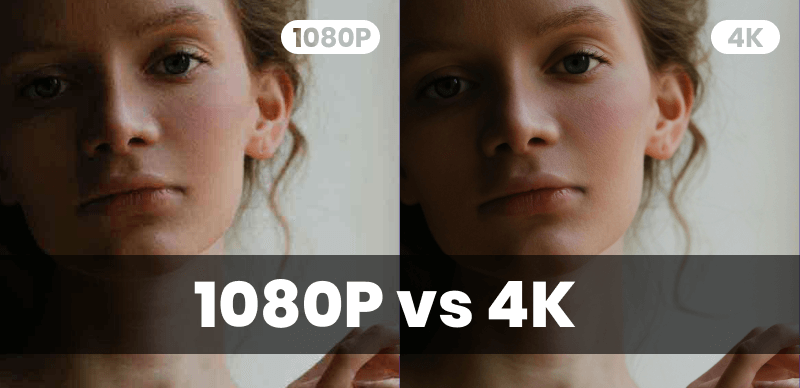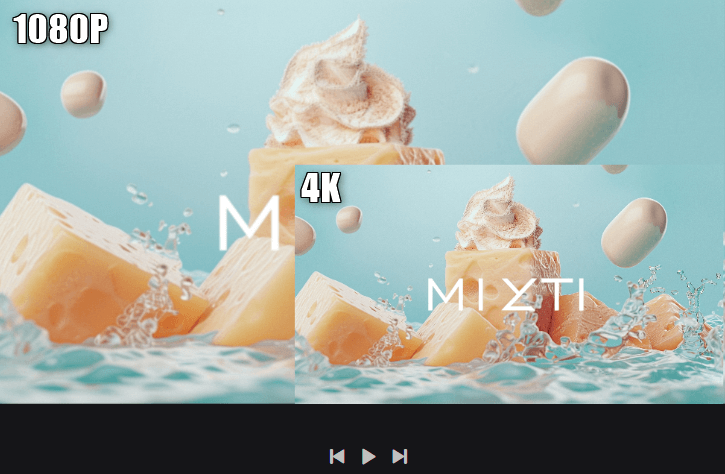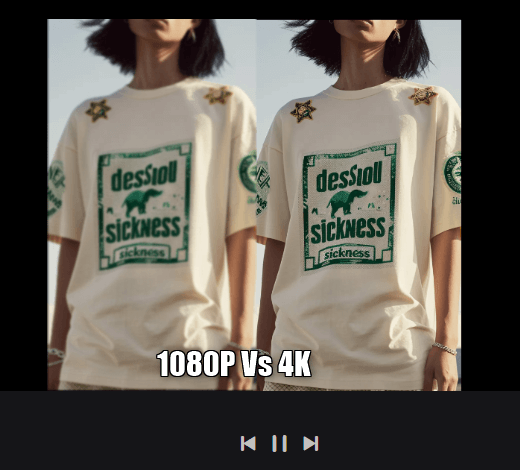In the realm of digital video and display technology, the terms 1080p and 4K have become pivotal in the ongoing quest for enhanced visual clarity and realism. As we embark on this comparison, we will examine the factors that influence the choice between 1080p and 4K, including the availability of content, the capabilities of display technology, the impact on system requirements, and the overall value proposition for different types of viewers.

1080p vs 4K
Whether you’re a home theater enthusiast, a professional content creator, or simply someone looking to upgrade your display setup, understanding the 1080p vs 4K resolution battle is essential to making an informed decision. Let’s unravel the nuances of this visual resolution face-off and discover which resolution best suits your needs.
Table of Contents: hide
Is It Better to Shoot in 4K or 1080p?
The Differences Between 1080p and 4K
Is It Better to Shoot in 4K or 1080p?
The choice between shooting in 4K or 1080p depends on several factors and your specific needs. Here are some considerations to help you make an informed decision:

1080P or 4K
📹 Resolution and Detail: 4K offers four times the resolution of 1080p, resulting in sharper and more detailed footage. If you need to capture fine details or plan to crop or zoom into your footage during video editing, shooting in 4K provides greater flexibility and better overall image quality.
📹 Future-Proofing: 4K is rapidly becoming the standard for video content. By shooting in 4K, you future-proof your footage, ensuring it remains relevant as more devices and platforms adopt 4K resolution. It allows for easier repurposing, editing, and distribution of your content in various formats.
📹 Downscaling and Editing Flexibility: Shooting in 4K gives you the option to downscale to 1080p during post-production. Downsampling 4K footage to 1080p can result in improved image quality, reduced noise, and enhanced color depth. It also provides more flexibility in editing, allowing you to reframe shots, stabilize footage, and apply digital zoom without sacrificing image quality.
📹 Storage and Processing Requirements: 4K footage requires significantly more storage space and processing power compared to 1080p. If you have limited storage capacity or your computer hardware is not powerful enough to handle 4K editing smoothly, shooting in 1080p may be a more practical choice.
📹 Delivery Platform and Audience: Consider the platform or medium where your content will be viewed. If your target audience predominantly watches videos on devices or platforms that support 4K playback, shooting in 4K ensures they can experience your content at its highest resolution. However, if your audience primarily consumes content on platforms or devices that do not fully support 4K, shooting in 1080p may be sufficient.
📹 Production Constraints: Production factors such as available budget, camera capabilities, and shooting conditions can influence your decision. Shooting in 4K may require higher-end cameras, more storage, and additional post-production resources. If these factors pose limitations, shooting in 1080p can still provide excellent results.
Also Read: How to Upscale AI Anime >
The Differences Between 1080p and 4K
4K and 1080p are terms used to describe the resolution of digital video and display technologies. 4K, also known as Ultra High Definition (UHD), offers a resolution of approximately 3840 x 2160 pixels, which is four times the pixel count of 1080p, resulting in a sharper and more detailed image. It provides a more immersive viewing experience, especially on larger screens or when viewed up close. On the other hand, 1080p, also referred to as Full High Definition (FHD), has a resolution of 1920 x 1080 pixels and is the standard for most current consumer displays and streaming services. While 1080p is lower in resolution compared to 4K, it is widely supported and offers a balance between image quality and file size, making it suitable for a broad range of applications. Both resolutions are presented in a 16:9 aspect ratio, which is the standard for high-definition televisions and monitors, ensuring a widescreen viewing experience.

1080P Vs 4K
1080p (Full High Definition):
- Still considered a high-quality resolution but has fewer pixels than 4K.
- More widely supported by current devices, including TVs, monitors, and streaming services.
- Files are smaller, making them easier to store and stream with less bandwidth.
- Sufficient for most consumer applications and is the standard for many online videos and broadcasts.
- Maybe less future-proof as higher-resolution displays become more common.
4K (Ultra High Definition):
- Offers a higher resolution with more pixels, which can result in a sharper image.
- Provides a larger color space and higher dynamic range, which can lead to more vibrant and lifelike colors.
- Files are larger, requiring more storage space and more bandwidth for streaming.
- May require more powerful hardware to edit and display effectively.
- Offers better future-proofing as screens and technology advance.
The Comparison of 1080p and 4K
| Performance | 4K | 1080p |
| Resolution | 3840 x 2160 pixels | 1920 x 1080 pixels |
| Aspect Ratio | 16:9 | 16:9 |
| Pixel Count | ~8.3 million | ~2.1 million |
| Image Quality | Higher | Lower |
| Color Depth | Typically higher | Typically lower |
| File Size | Larger | Smaller |
| Streaming | More bandwidth required | Less bandwidth required |
| Compatibility | Newer devices support 4K | Less future-proof |
| Future Proofing | More future-proof | Less future-proof |
Is It Possible to Convert 1080p to 4K?
Converting 1080p footage to true 4K resolution is not possible in a literal sense. 4K resolution contains 4 times the number of pixels compared to 1080p, which means there is simply not enough original information in a 1080p video to create a true 4K image.
However, there are 1080p to 4k converters that can be used to enhance the appearance of a 1080p video. When converting 1080p footage to 4K using such a converter, the process typically involves upscaling the resolution to match the 4K dimensions. While it’s important to note that this conversion cannot add the same level of detail as native 4K content, a converter can enhance the appearance of the footage by utilizing advanced algorithms and techniques.
What Happens When You Watch 1080p on 4K?
When you watch 1080p content on a 4K display, several things can happen depending on the capabilities of the 4K TV or monitor and the nature of the content:
- Upscaling: Most 4K displays have built-in upscaling (also known as upconversion) technology that increases the resolution of the 1080p content to match the screen’s native resolution. This process uses various algorithms to approximate the additional pixels needed to fill the 4K screen.
- Improved Detail: Upscaling can result in a more detailed image compared to the original 1080p resolution, especially if the upscaling algorithm is sophisticated. However, the image will not have the same level of detail as native 4K content because the additional pixels are not original but are generated by the TV’s processor.
- Smoother Motion: Some upscaling techniques can make motion appear smoother, as the TV effectively adds frames to the content, which can be beneficial for fast-paced action scenes.
- Loss of Sharpness: In some cases, if the upscaling algorithm is not advanced or if the content has a lot of fine detail or text, the upscaled 4K video might not appear as sharp as the native 1080p version.
- Artifacts and Noise: Poor upscaling can sometimes introduce artifacts or noise into the image, although most modern 4K TVs do a good job of minimizing these issues.
- Color and Contrast: Upscaling does not typically affect the color or contrast of the image, but a good upscaling algorithm can help maintain the color accuracy and contrast ratio of the original content.
- HDR Enhancement: If the 4K display supports High Dynamic Range (HDR) and the 1080p content has metadata for HDR, the TV might enhance the color and contrast of the image to take advantage of the display’s HDR capabilities.
- Source Quality: The quality of the upscaled video can also be influenced by the video quality of the source content. Higher-quality 1080p content will generally upscale better than lower-quality content.
- Viewer Perception: The perceived improvement in image quality can be subjective and may vary from viewer to viewer.
It’s important to note that while upscaling can enhance the appearance of 1080p content on a 4K display, it does not make the content “true 4K” or provide the same level of detail as native 4K content.
Final Thought
In conclusion, the debate between 1080p and 4K resolutions is one that revolves around visual clarity and detail. While 1080p offers a solid level of resolution that is suitable for most viewing experiences, 4K takes it a step further by providing even greater detail and sharpness. However, the benefits of 4K are most noticeable on larger screens or when viewing content up close. Ultimately, the choice between 1080p and 4K depends on individual preferences, the size of the display, the content being viewed, and the availability of 4K-compatible devices. As technology continues to advance, 4K is becoming increasingly prevalent, but both resolutions can provide enjoyable viewing experiences depending on the circumstances.
